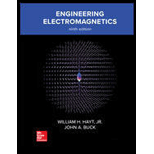
Concept explainers
At large distances from a dipole antenna (to be addressed in Chapter 14), the electric field amplitude that it radiates assumes the simplified form
where A is a constant. A second dipole antenna, receiving radiation from the first is located at distance r from the first, has length L, and is oriented along the aθ direction, thus presenting its full length to the transmitting antenna at the origin. The angular position of the receiving antenna is θ = θ0, As observed from the transmitting antenna, the receiving antenna subtends angle AG. (a) Find the voltage amplitude across the length of the receiving antenna, and express your result in terms of A, Q0, L, and r. (b) Specialize your result for the case in which L <
Want to see the full answer?
Check out a sample textbook solution
Chapter 4 Solutions
Engineering Electromagnetics
- Distance between two points P (x = 2, y = 3, z = -1) and Q(r = 5, θ = 30 , φ =60)arrow_forwardA Moving to another question will save this response. Quèstion 2 Magnitude of dipole moment is given by O qd d/q None Moving to another question will save this response.arrow_forwardIf the maximum dimension of an antenna is 0.15 m and the frequency is 1 * GHz the distance 0.5 m representsarrow_forward
- An imaging sequence often involves a series of excitation pulses to generate signals to cover k−space. Since a π/2−pulse completely rotates any available Mz component onto the transverse plane, magnetization along the z−axis is always zero immediately after a π/2−pulse in any imaging sequence with π/2−pulses. True or false??arrow_forwardThe half power beam width of an antenna in both θ and φ are 400 each. Then the gain of the antenna is: a) 23 b) 25 c) 14 d) 27arrow_forwardDerive the law for the amplitude of the sphere c = 4Tte/1/a-1/barrow_forward
- An antenna radiates in free space and 12 sin e - cos(27 X 10°t – Br)ag mA/m H = Find the corresponding E in terms of B.arrow_forward9. If the beam width of an antenna in two orthogonal planes are 30° and 60°. Then the directivity of the antenna is: a) b) 18 c) 36 d) 12 24 ECarrow_forward1. In an isotropic source, the directivity is unity because No one of them Uo, U and Umax are equal to each other Uo, U and Umax are different from each other 2. If the radiation lobe in a direction different form the intended lobe. the lobe called back lobe Major lobe side lobe 3. If the radiating property of an antenna is best in some directions than in others, this called Omnidirectional Radiator Directional Radiator Isotropic Radiator.arrow_forward
- Given A=10253.13° and B=10436.87°, calculate the product in both polar and rectangular forms.arrow_forwardTwo antennas located at points A and B are broadcasting radio waves of frequency 96.0 MHz, perfectly in phase with each other. The two antennas are separated by a distance d= 6.20 m. An observer, P, is located on the x axis, a distance x= 84.0 m from antenna A, so that APB forms a right triangle with PB as hypotenuse. What is the phase difference between the waves arriving at P from antennas A and B? A P X 4.594x10-¹ rad Computer's answer now shown above. You are correct. Previous Tries Your receipt no. is 158-6031 > Now observer P walks along the x axis toward antenna A. What is P's distance from A when he first observes fully destructive interference between the two waves? 1.152x10¹ m Computer's answer now shown above. Incorrect. Tries 1/6 Previous Tries If observer P continues walking until he reaches antenna A, at how many places along the x axis (including the place you found in the previous problem) will he detect minima in the radio signal, due to destructive interference? 2.000…arrow_forwardA dielectric material contains 3x 1020 polar molecules/m3, each of dipole moment 5 x 10-29 C.m. What is the polarization field, P? Lütfen birini seçin: a. 15 nC/m2 b. 30 nC/m2 c. 18 nC/m2 d. 20 nC/m2 e. 25 nC/m2arrow_forward
 Introductory Circuit Analysis (13th Edition)Electrical EngineeringISBN:9780133923605Author:Robert L. BoylestadPublisher:PEARSON
Introductory Circuit Analysis (13th Edition)Electrical EngineeringISBN:9780133923605Author:Robert L. BoylestadPublisher:PEARSON Delmar's Standard Textbook Of ElectricityElectrical EngineeringISBN:9781337900348Author:Stephen L. HermanPublisher:Cengage Learning
Delmar's Standard Textbook Of ElectricityElectrical EngineeringISBN:9781337900348Author:Stephen L. HermanPublisher:Cengage Learning Programmable Logic ControllersElectrical EngineeringISBN:9780073373843Author:Frank D. PetruzellaPublisher:McGraw-Hill Education
Programmable Logic ControllersElectrical EngineeringISBN:9780073373843Author:Frank D. PetruzellaPublisher:McGraw-Hill Education Fundamentals of Electric CircuitsElectrical EngineeringISBN:9780078028229Author:Charles K Alexander, Matthew SadikuPublisher:McGraw-Hill Education
Fundamentals of Electric CircuitsElectrical EngineeringISBN:9780078028229Author:Charles K Alexander, Matthew SadikuPublisher:McGraw-Hill Education Electric Circuits. (11th Edition)Electrical EngineeringISBN:9780134746968Author:James W. Nilsson, Susan RiedelPublisher:PEARSON
Electric Circuits. (11th Edition)Electrical EngineeringISBN:9780134746968Author:James W. Nilsson, Susan RiedelPublisher:PEARSON Engineering ElectromagneticsElectrical EngineeringISBN:9780078028151Author:Hayt, William H. (william Hart), Jr, BUCK, John A.Publisher:Mcgraw-hill Education,
Engineering ElectromagneticsElectrical EngineeringISBN:9780078028151Author:Hayt, William H. (william Hart), Jr, BUCK, John A.Publisher:Mcgraw-hill Education,





